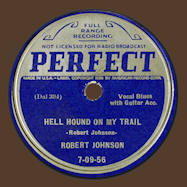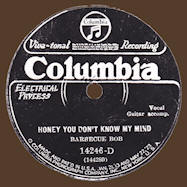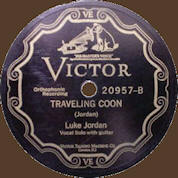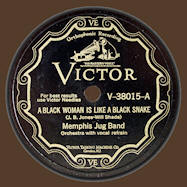
Painting © 2004 Loz
Arkle
Website
© Copyright 2000-2011 Alan White - All
Rights Reserved
Site optimised for Microsoft Internet Explorer
British Superstitions and the Blues |
||||||||||||||
|
Conclusion As I have already said, many superstitions and beliefs that I have cited could have appeared virtually anywhere in the world where rural and/or 'primitive' communities made their home. Indeed, in the case of the hell hound it could be argued it was a universal phenomenon. But if it is, which I doubt, one of the main reasons for its widespread popularity would be the adoption of ancient Greek and Roman legends by Christianity. Where the latter went, so too did the Christian version of Cerberus. Similarly the concept of the 'evil eye' was not peculiar to the British Isles. Yet every belief has a beginning and if popular enough will be maintained by succeeding generations of the population concerned. Eventually, as the latter start to push their geographical horizons to outer limits, they carry these beliefs with them. Although there might be more than one such beginning, the dominant culture's superstitions are the ones most adhered to or at least remembered by the emerging new society. Such is the case when the British colonised what was to become the United States, in the seventeenth century. Although other cultures were present, that of the British Isles came to predominate, at least in the South. Not only did the first African slaves adopt their captors' language, out of necessity for communication, but also subsequent generations of blacks took on some of the customs, beliefs and superstitions of the dominant culture as their African origins receded in the memory. It is true there were, and are, some retentions of African lineage including some pockets of isolated communities, such as those on the Sea islands off Georgia and the Carolinas. But they are exceptions. The majority of blacks would have clearer mental images of British traditional beliefs from the 17th. century which were perpetuated into the twentieth; than those from African origins in the 1500's; growing more shadowy with the passage of time. As I have said, there are overlaps where a superstition from West Africa travels the same path as one from England, for example. Writers reported to the Works Project Administration (W.P.A.) in 1940, that beliefs had been collected from coastal blacks in Georgia, which included one where a person was very careful how they disposed of their nail clippings and hair-cuttings as they didn't want a hoodoo man to make a charm, such as a mojo hand, to be used against them. They believed that the power of hoodoo could gain access to a person's spirit if these ingredients were included in such a charm. The opinion was that this was a belief that stemmed from West Africa, according to informants in the survey. However, it seems that a parallel existed in English folklore: "Milk-teeth, nail-parings and hair-clippings should be burnt, lest they fall into the hands of a witch."(1). Along the Georgia coastline blacks too preferred to burn these items, but would also consider burying them or throwing them in a fast-flowing river. The conjure/hoodoo man is another case in point; and although the actual concept of a witch is very European, the ideas of evil spirits and putting a 'hex' on somebody were just as prevalent in Africa. But the witch survived in American black folklore whereas the 'Leopard Man' and the 'Snake Goddesses, etc, did not. Nineteenth century rural Britain appeared to be infested with the phenomena of witches and the 'Evil Eye'. The latter showed up in at least one Blues, by the Memphis Jug Band and titles alluding to the former include "Witchin' Hour Blues" by Tampa Red in 1934, and even a "Witchcraft Blues" by Victoria Spivey in 1937; both recorded in Chicago. Further to this, such English witches' spells incorporating the intended victim's urine, amongst other personal effects, seemed to be utilised by black communities in the Deep South and survived into the present century. Many Blues recorded in the 1920's and 30's referred to these spells (see, Tables A & B). But other beliefs and customs, as Paul Oliver has said, seem to have Anglo-Saxon origins. In the case of the rabbit/hare's foot, the turpentine/sugar cure, removal of a pillow from a person's dying bed, and the phenomenon of the 'Traveling Man', for example, the source points to Britain in general, and England and 'Wales in particular. As we have seen, all these phenomena turned up in the Blues, in one way or another. Many superstitions were shared by U.S. (not necessarily just black) and British inhabitants. For instance "From Lincolnshire to Tennessee it was unlucky to bring eggs into the house after sunset,"(2), and was a popular belief in the nineteenth century. Another custom that transferred to the U.S. was the one where "All evergreens (except mistletoe which was kept in farmhouses in Worcestershire against the evil eye) must be burned out of doors, and in the United States the custom of burning household decorations in parks has grown in compliance with the old belief."(3).
These
customs and beliefs crossed the Atlantic Ocean either with the early
settlers and indentured servants in the 17th. and 18th. centuries from
British shores, or via oral transmission by sea in the nineteenth. It is
obvious that the influence on working-class blacks in the Southern
states, from superstitions firmly rooted in Britain, are a strong
non-African connection with the Blues, and must be considered alongside
of, not instead of, those from the 'Dark Continent!. Notes 1.Hole.ibid.9, 2.Raker.ibid.p.76.
3.Ibid.p.88. © Copyright 1992 Max
Haymes
Back
to essay overview
Website © Copyright 2000-2011 Alan White. All Rights Reserved. |
||||||||||||||












